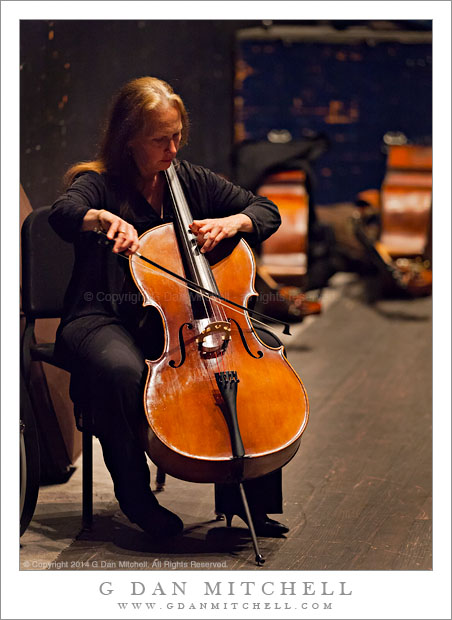
Cellist Louella Hasbun. San Jose, California. May 17, 2014. © Copyright 2014 G Dan Mitchell – all rights reserved.
Cellist Louella Hasbun practices backstage during intermission at a performance of the Symphony Silicon Valley
I’m going to make this partial a story about photography and partially a story about musicians—but first some quick background. I have been an “embedded photographer” with two classical music performing groups since the fall of 2012 while working on a project that will continue through the fall of 2014. The nature of the project is a bit of a long story, so I won’t go into the details here, except to say that I am fortunate to have what must be nearly unprecedented access to the world of these wonderful artists. I like to think that the lengthy time I have had to work with them has let me develop a special affinity for them and what they do, and I think that it has also allowed them to come to trust me and what I’m going as I photograph them. There are few endeavors that regularly exhibit the same level of physical, mental, and aesthetic focus and energy as music. There is a raw power in watching this when scores of performers work together in an orchestral performance, but there is also a very special power in the intense inward focus on individual performers, too.
As I have worked with the orchestras I have learned a lot of practical things about how to photograph them. Some are simple and mundane—such as what equipment works well for my approach. Others are a bit more complicated to explain—such as how to anticipate and capture momentary expressions that come and go so fast that they are perhaps not seen by those who don’t know to look for them, or how to photograph musicians in moments of peak engagement, or how to use stage and backstage lighting to best advantage, or how to see a short-lived moment and quickly make a photograph in poor light and without intruding on that moment. This photograph perhaps illustrates the last two of those points. Over time I have learned to look for what I think of as “pools of light” in the backstage environment. Much of this environment is quite badly lit, both in terms of the levels and the quality of the light. But there are a few spots that I have found where a small area may fall under a work light or similar. I watch these areas intently, and any time someone “lands” in one of them I watch to see if a photograph develops. For a moment, this cellist sat in one of those “pools of light” and, focusing inwardly, practiced intently for a few moments. It is almost like photographing wildlife, and I had just an instant to find a composition and make a few exposures before the moment was over.
 G Dan Mitchell is a California photographer and visual opportunist whose subjects include the Pacific coast, redwood forests, central California oak/grasslands, the Sierra Nevada, California deserts, urban landscapes, night photography, and more.
G Dan Mitchell is a California photographer and visual opportunist whose subjects include the Pacific coast, redwood forests, central California oak/grasslands, the Sierra Nevada, California deserts, urban landscapes, night photography, and more.
Blog | About | Flickr | Twitter | Facebook | Google+ | 500px.com | LinkedIn | Email
Text, photographs, and other media are © Copyright G Dan Mitchell (or others when indicated) and are not in the public domain and may not be used on websites, blogs, or in other media without advance permission from G Dan Mitchell.
Discover more from G Dan Mitchell Photography
Subscribe to get the latest posts sent to your email.

Ah, I found them group of pictures – in Performing Arts in your Gallery.
I totally understand you Dan as I take photos of an orchestra. I’d love to get some really good photos of our conductor, but it is very difficult. Besides the bad lighting, he is always moving, and sometime moving very fast. And all the either empty seats behind him in rehearsal look horrible. During a concert the lighting in our hall makes that picture all but impossible.
Over the years I’ve gotten some photos that, while I really liked them, were quickly deleted by me so as not to embarrass anyone – like the flutist sticking her tongue out as the shutter closed. Or the expressions when a bad note is played. And puffy cheeks on the wind players.
Sometimes there are wonderful pictures of just the instruments. I’ve also learned that there is often a lot of history behind an instrument – their stories are always interesting to listen to.
By any chance is there a way to see all your music photos in one spot?
Thanks, Ernie. I see that you found a bunch of the photos. (There are quite a few more coming, too. I now have over 5000 frames of these two groups!)
At some point I will share a post or two with some things I have learned about photographing musicians.
Dan